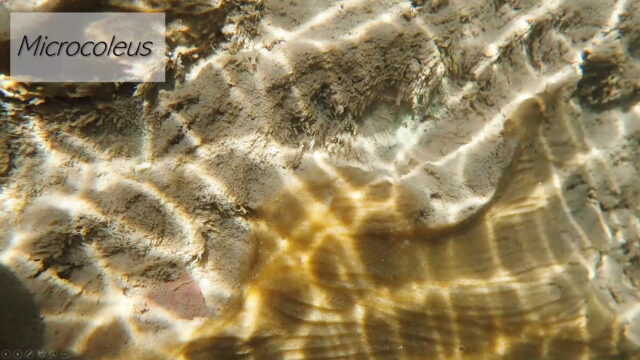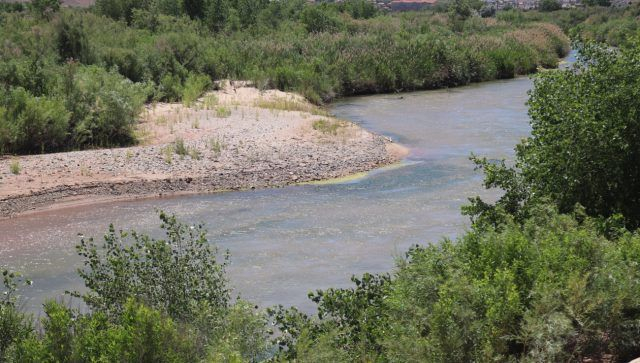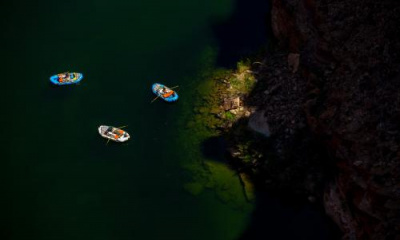ST. GEORGE — With the temperatures on the rise, those familiar with the cyanobacteria previously found in the Virgin River and other water bodies across the state may be asking: Is it safe to go back in the water?
For nearly four years now – from LaVerkin Creek to the North Fork in Zion National Park and south into St. George and Arizona – the lingering presence of harmful algae blooms in the Virgin River that produces toxic bacteria has been the subject of recurring health advisories and warnings from state and federal agencies.
The bacteria produced by the blooms can be harmful to humans and pets, particularly dogs.
“If people know what to look for when it comes to these harmful algae mats, they can make good recreational decisions,” Dr. Hannah Bonner, the Utah Division of Water Quality’s recreational water quality program coordinator, told St. George News.
“If you know how to identify a mat before you, your kid, (or) your dog goes to swim in something like the Virgin River, it’s really easy to take a few minutes to walk around and make sure you’re not seeing any suspicious growth,” Bonner said. “If you’re not seeing anything, then you can recreate with confidence and not be afraid. But if you do find something suspicious, then you can also be empowered to say, ‘Oh, OK, I’m going to go recreate somewhere else today.’”
Learning how to identify the algae mats that produce the harmful blooms and information on the current status of the Virgin River can be found on the Utah Department of Environmental Quality website.
The website features galleries showcasing the various types of algae blooms and mats to watch out for, as well as an interactive map of the state showing water bodies where the presence of toxic algal blooms has been confirmed.
What to look for
The type of algal blooms that have developed in the Virgin River are called “benthic mats.”
Bonner described the algae as having a mucus-like, viscous and “goopy” texture that is anywhere from a centimeter to an inch in thickness and grows submerged. It is often attached to rocks and vegetation.

Examples of the cyanobacteria algal blooms found in the Virgin River in Zion National Park, Utah, 2021 | Photo courtesy of Zion National Park, St. George News
“If you see that, that’s what you want to avoid,” she said.
The state website also offers a six-page guide on how to identify the presence of harmful algal blooms, which can be found here. Zion National Park also has posted information on its website for visitors.
The harmful algal blooms were first detected in the North Fork of the Virgin River in Zion National Park in July 2020 following the death of a Siberian Husky pup that ingested some of the algae while visiting the park with its owner’s family.
Harmful algal blooms were then discovered in LaVerkin Creek and North Creek and eventually the rest of the river south of the national park from Springdale down to the Bloomington area.
“We should definitely be aware of this and taking careful actions, but also it doesn’t mean you can never play in the water,” Bonner said.
Why the algal mats and toxins they produce should be avoided
The algal blooms produce cyanobacteria, also known as “blue-green algae,” which is naturally occurring in waterbodies and can be found floating on top of water or throughout the water column, according to the National Park Service. In the case of the Virgin River, the algae usually forms on the bottom of the river and is known as “benthic cyanobacteria.” This can grow on rocks, plants, at the sides of the rivers or along the river’s edge.
The algae is also photosynthetic, meaning it can grow in water wherever sunlight reaches.
When the algae blooms, it produces large amounts of cyanotoxins. Symptoms of possible exposure to cyanotoxins can include but are not limited to skin rash, salivation, drowsiness, tingling, burning, numbness, pain, incoherent speech, seizures, vomiting and diarrhea.
Drinking toxin-contaminated water may also result in liver and kidney damage. Attempting to filter or boil water does not remove the cyanotoxins. It is recommended that if you must filter water, get it directly from the spring source.
Contact the Utah Poison Control Center at 1-800-222-1222 with concerns about cyanotoxin poisoning, and call 911 in the event of a medical emergency.
Cyanobacteria is especially dangerous to dogs who appear to be attracted to the smell the toxic algae gives off, Bonner said.
If you suspect your pet has been exposed to a harmful algal bloom, officials advise you to seek immediate care from a veterinarian.
According to the Cornell University College of Veterinary Medicine, symptoms of exposure in dogs can include vomiting, diarrhea, weakness, pale gums, collapsing, drooling muscle tremors, difficulty breathing, muscle rigidity, paralysis, seizures and sudden death. The onset of systems can occur within 30-60 minutes of exposure.
Concerning the Virgin River proper, Bonner said the water quality is fine as all of the toxins are in the algal mat and aren’t a serious threat otherwise unless somehow ingested.
Because of this, the Utah Department of Environmental Quality warns against swimming or submerging in the river and urges the public to take note of current warning levels.
Three degrees of algal bloom warnings: Health watch, warning advisory and danger warning
The three levels of warnings for harmful algal blooms observed in Zion National Park and by the state overall are set by the Utah Department of Environmental Quality.
A health watch is the lowest advisory level and is considered an informal warning that elements of harmful algal bloom are likely present. Recreators are asked to exercise caution when interacting with a possibly contaminated water source.
A warning advisory is issued when the recorded levels of algal bloom toxins exceed thresholds where harm is known to occur that can result in either short- or long-term illness. At this point, warning signs are posted at primary recreation sites, and weekly analysis of the contaminated waterbodies is recommended.
A danger advisory results in the closure of the contaminated area as toxins levels can lead to acute poisoning at that point. Danger signs are posted, and analysis of the water is recommended to be taken at least once a week.
The last time the levels of algal bloom toxins in the Virgin River were recorded was March 14. In Zion National Park, warning advisories were issued for North Creek and the North Fork of the Virgin River while a health watch was issued for LaVerkin Creek. The rest of the Virgin River is also currently under a health watch.
The Virgin River was recorded to be at high toxin levels during November 2022 while the following summer saw those levels drop to their lowest since 2020 due to winter runoff scouring the river of benthic mats.








